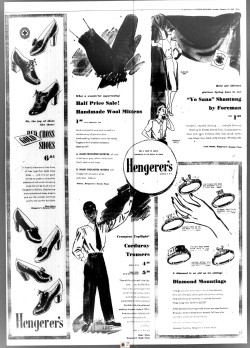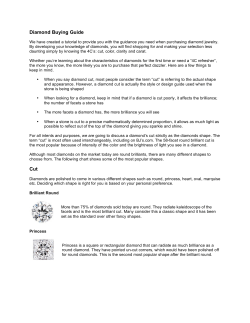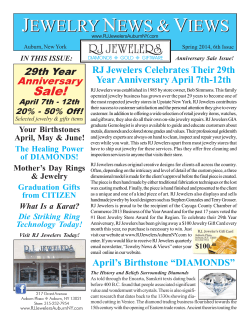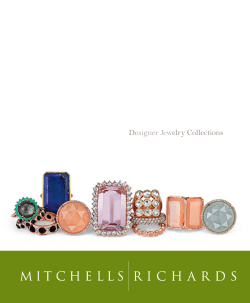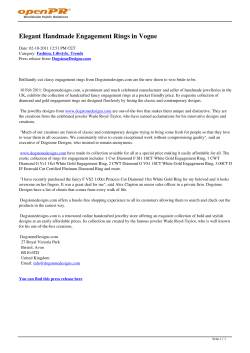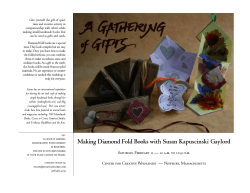
asscher
how to buy
a diamond
THE 4 Cs
asscher
The asscher, often called the “square emerald cut,” has stepped facets. With its
extra faceting, this cut has more brilliance and has become a new favorite for
trend-setting brides.
baguette
Diamonds are among the rarest substances on earth. These beautiful gifts of
nature, formed billions of years ago deep below the surface, shine with a fire
and brilliance like no other gemstone. Although we still know relatively little
about how diamonds are formed, there is a simple way to assess their quality
and understand their relative value. This is done by grading the Cut, Clarity,
Color and number of Carats in a stone. Known as the 4 Cs, this process provides
a useful summary of a stone’s key characteristics. As a further guarantee,
quality diamonds always come with a grading report that explains each of these
measurements in more detail.
cut
In many ways, the cut of a diamond is the least understood of the 4 Cs. It is
often thought that the cut of a diamond refers to whether it is, for example,
round or oval. In fact, the term “cut” covers not only the shape of the stone, but
also its angles, proportions, polish and symmetry.
The way a diamond is cut determines how light enters and leaves the stone,
which determines how much “life” and “fire” it has. An ideal-cut round diamond
has 56 different surfaces, or “facets.” Those on the crown or top gather light
into the center of the stone, while the pavilion’s facets bounce the light back
and forth before reflecting it back out through the crown.
Only a small deviation in the angles or shapes of the facets will allow light to
“leak” from the stone and cause it to lose much of its natural brilliance. This
also occurs if, for example, too many facets are cut into the stone, the table is
too large or poorly centered, or the girdle is too thick. Many people in the trade
think that cut is the most important of the 4 Cs, as a well-cut diamond will look
more beautiful to the eye than a less well-cut stone. Sam’s Club® uses only the
most skilled diamond cutters, and every diamond is reinspected before it is
shipped to make sure we have the very best quality.
A non-assuming stone, the baguette is a cut with step like facets that is usually
used as an adornment to a large center stone.
cushion
This vintage style is a beautiful traditional cut that is currently having a
renaissance. It has the appeal of an antique look that your great-grandmother may
have worn.
emerald
The emerald cut is a sophisticated yet understated cut considered to be of the
highest taste level. Known as a “step cut,“ the facets are broad with flat planes.
Higher quality is more important with emeralds than other cuts because both
inclusions and lower color are more noticeable.
heart
This fun cut is so special and, quite literally, lets the recipient know how you feel.
marquise
The marquise, also called navette or boat shape, is a 56-facet grand cut that gives
the appearance of royalty. Any woman who wears it feels like a queen.
oval
A twist on the classic round cut, the 56-facet oval is for the woman who wants to be
a little different yet still classic.
pear
A combination of a round brilliant and a marquise cut, this old-fashioned cut is
unique. Its stunning sparkle and character is perfect for the woman who wants her
diamond to do all the talking.
princess
The princess cut is high on sparkle, glamour and simple great taste. This
contemporary cut is a stylish showstopper that combines the sparkle of a round
brilliant and a square/rectangle shape.
round
With its 58 sparkling facets, round is the most popular cut in America. This cut is
the most classic choice for an engagement ring.
radiant
This adaptation combining the emerald cut with the princess cut has extra faceting
on its underside for extra shine and extravagance. It brings out the
movie-star quality in all women.
trillion
This bold cut has a lot of sparkle and light in its 50 facets. It’s perfect for making a
statement and should be worn by women who have as much fire as it does.
(left) 1.50 ct. I-V2 round ideal-cut diamond
(center) 1.70 ct. I-VS1 radiant-cut diamond
(right) 1.52 ct. G-VS2 marquise-shape diamond
Quantities and styles may vary by Club. Carat weight and
carat total weight (CT.) (CT. T.W.) are approximate and vary
by .05 carat. Typographic errors are subject to correction.
Jewelry items may be enlarged to show beauty of detail.
2 | Sam’s Club Source™ | FEB|08
0208Feb_02-05_BuyDiamond.indd 2
1/9/08 10:55:35 AM
carat
color
clarity
The number of carats in a diamond relates to its weight.
Historically, a one-carat diamond was equal in weight
to a seed or bean from the Mediterranean Carob tree.
In the Far East, a one-carat diamond was equal to the
weight of four grains of rice. Today a metric carat is
200 milligrams, or 0.20 grams, in weight. A carat may be
divided into 100 “points”–so a 0.75-ct. diamond is called
a 75-point diamond. Sometimes people refer to 0.25
ct. as one “grain,” so a 0.75-ct. diamond is sometimes
referred to as a “3 grainer.”
Nearly all diamonds have some tint of yellow or brown.
This color is entirely natural and comes from impurities
embedded in the diamond from the time it was made.
To accurately determine a diamond’s color grade using
Gemological Institute of America (GIA) standards,
the diamond is viewed, table down, under controlled
conditions and compared to a “Master Set” whose
colors have been predetermined by the GIA. Sam’s Club
diamonds are carefully color-graded by experienced
professional graders according to these guidelines.
It is obvious that the heavier a diamond is, the more
valuable it will be. However, as cut, clarity and color also
help to determine value, it is possible that a smaller
stone will be more valuable than a larger diamond with
inferior characteristics. For this reason, stones of equal
weight can also vary a great deal in price. Diamond
sizes are rarer as they get larger. Only one diamond
in a thousand is larger than one carat, and more than
1,250 tons of rock need to be mined to find just this one
stone. The higher price per carat paid for a larger stone
reflects this greater rarity. Sam’s Club regularly tests for
stone weight on all items.
The most commonly accepted scale for measuring color
uses letters ranging from D (colorless, or white) through
to Z (light yellow). Outside this range, diamonds are
called “fancy color” and can be blue, pink, yellow or even
red or green. Within the D-Z range, diamonds are graded
by their relative lack of color. Although most gemquality diamonds appear to be colorless to the untrained
eye, there are subtle differences in the shade, which in
turn affect value. Diamonds with no traces of body color
are extremely rare. White diamonds (D–I) are set off well
by white gold or platinum, while yellow diamonds (J–Z)
respond better to yellow gold. Your Sam’s Club sales
Associate will help you choose a diamond that is not only
breathtaking, but also suits your budget.
Unlike carat weight or color, the clarity of a diamond is
a matter of judgment by trained gemologists. Very few
diamonds are truly without fault. Nearly all have internal
imperfections (inclusions) or surface irregularities
(blemishes). These characteristics of nature give each
stone its own unique signature and help to identify
it as a 100 percent natural product. All Sam’s Club
diamonds are graded for clarity by professionally
trained, experienced graders according to the guidelines
established by the GIA. The GIA discovers, imparts and
applies gemological knowledge to ensure the public
trust in gems and jewelry. Sam’s Club offers diamonds
with a range of clarity, so you’ll be sure to find the
diamond that’s perfect for you.
F1flawless
IFinternally flawless
,%''
+%''
*%''
D, E & F
(%,'
(%),
G, H & I
'%,'
'%),
'%('
VVS1, very very slightly VVS2included
J,K,L & M
faint yellow
(%''
S through Z
'%.,
Free from inclusions. May have slight blemishes when magnified.
Very rare and expensive.
)%''
colorless (white) nearly colorless
(%.,
Free from inclusions and blemishes.
Extremely rare and expensive.
light yellow
Has inclusions or blemishes smaller than a the size of a pinpoint.
Rare and expensive.
N, O, P, Q & R
very light yellow
VS1, very slightly included
VS2 Has inclusions or blemishes smaller than a grain of salt. Very high quality.
SI1, slightly included
SI2 Has inclusions or blemishes larger than a grain of salt. High quality.
I1included
Has natural inclusions visible to the
naked eye.
I2, I3 Quality lower than
how to buy
a diamond
0208Feb_02-05_BuyDiamond.indd 3
Sam’s Club standards
Quantities and styles may vary by Club. Carat weight and
carat total weight (CT.) (CT. T.W.) are approximate and vary
by .05 carat. Typographic errors are subject to correction.
Jewelry items may be enlarged to show beauty of detail.
FEB|08 | Sam’s Club Source™ | 3
1/9/08 10:55:56 AM
settings
bezel
A metal rim with straight or scalloped edges surrounds the perimeter of the stone.
half bezel
A metal rim partially surrounds the stone, leaving part of the diamond’s girdle exposed.
prong
A metal “head” or “basket” consisting of between three and six claws holds the stone in
place. Prongs may be pointed, rounded, flat or V-shaped.
tension
The stone gives the impression that it is floating due to compression-spring pressure that
holds the stone firmly in place.
bar
Thin vertical bars of metal separate and secure the stones. A bar setting may be applied
around part or all of a ring.
channel
Two horizontal grooves or channels sandwich a row of stones without using metal to
separate the stones. Very popular setting for wedding bands.
gypsy
Each stone is set flush into a hole and secured by pressing and hammering metal around the
stone’s perimeter.
pavé
Raised metal formed into beads secures small stones into place. The stones are usually in
rows of three or more and are flush with the metal.
split shank
Open-center, forked metal supports hold the diamond securely on each side.
This setting is reminiscent of architectural supports in buildings or bridges.
metals
The symbol “K” is an abbreviation for the word karat. The
karat is a measure of gold’s purity. The higher the value of
K means the gold is purer but also softer. Alloys are commonly
added to gold to strengthen the metal and make a piece of jewelry
more durable. Most rings are made from either 14K or 18K gold.
The most common shades of gold are yellow and white.
sparkle
Polished diamonds sparkle with fire and light, radiance
and natural beauty. But once they join the stresses and
strains of our busy lives, their natural beauty can quickly be
tarnished. Makeup, soap, dishwater, newsprint and even
the natural oils and salts in your skin will dull your diamond
and prevent its natural brilliance from shining through.
We recommend that you use a soft cloth to polish your
diamond every day, to help keep its natural luster. Once a
week, use a soft toothbrush and some gentle detergent
dissolved in warm water to give your diamond a more
thorough cleaning. Some people even use vodka or gin
with ice instead of warm water. Either will keep your
diamond clean and shining bright.
taking good care
Your diamond is precious. Always take extra care when
wearing your jewelry in the bathroom or the kitchen. If
you knock your diamond or brush it too vigorously when
cleaning, the stone can become loose in its setting and
you could risk losing it.
keeping it safe
platinum
Platinum is a significantly stronger and denser metal than gold.
It is also a rarer metal and, therefore, is more costly when
considering a setting. Platinum is identified by a stamp such as
PLAT, PT 950 or .95 PLAT.
palladium
Alone or alloyed with silver or gold, palladium offers some of the
same metal-working properties as other jewelry metals and remains
tarnish free. It is more precious than silver and whiter than platinum.
Because it is nearly half the weight of platinum, more intricate
jewelry is capable of bearing larger gemstones without gain in
overall weight.
0208Feb_02-05_BuyDiamond.indd 4
Your diamond is a rare and beautiful product of nature.
Already millions of years old, it will last you forever.
However, all jewelry benefits from regular cleaning and
occasional maintenance. With a little care, it’s easy to
keep it looking as beautiful as the day it was purchased.
We also recommend that you remove your jewelry before
applying hand lotions, hairsprays or other cosmetics
as their ingredients can damage the surface of the diamond.
Always remove your jewelry before gardening or playing
sports as these can damage the stone or its setting. And
finally, we advise against swimming with your jewelry,
especially in chlorinated pools that can bleach precious
stones and metals.
gold
4 | Sam’s Club Source™ | FEB|08
love your diamond
1.10 ct. round-cut center diamond set in
14K yellow gold (top left) 0.96 ct. I-S12
excellent-cut center diamond set in 18K
white gold (right) 1.2 ct. oval-cut center
diamond set in 14K yellow gold (bottom).
Quantities and styles may vary by Club. Carat weight and
carat total weight (CT.) (CT. T.W.) are approximate and vary
by .05 carat. Typographic errors are subject to correction.
Jewelry items may be enlarged to show beauty of detail.
Diamond is the hardest substance on earth. Your
diamond will scratch all other gemstones, including
rubies, sapphires, emeralds and precious metals like
gold, silver or platinum. For that reason, keep it in its
original pouch or box. When traveling, use a jewelry
box or roll with individual padded slots for rings, and
posts for necklaces or bracelets. Always pad your
jewelry safely in your luggage.
Many people ignore the benefits of insurance and the
peace of mind that it brings. Being the victim of theft is
shocking and unsettling enough. The loss of a precious
memento makes it even more so. Your jeweler can give
you advice on how and with whom you should protect
yourself against this risk.
1/9/08 10:56:17 AM
buying diamonds
at sam’s club
®
Buying diamonds at Sam’s Club is the best kept secret
in the world, according to diamond merchant Sam Offir.
“Sam’s Club is ‘the’ destination for diamonds. The certified
diamonds available at the Sam’s Club jewelry counters,
on the Web site and as special-order items are second to
none. We dare anyone to compare,” said Offir, the marketing
director of Universal Pacific, which is one of the highly
esteemed diamond suppliers to Sam’s Club.
Exceptional quality and unbeatable value are the main
reasons to purchase diamond jewelry at Sam’s Club, said
Birain Parikh, VP of sales for Rosy Blue, another wellrespected diamond merchant. Both Universal Pacific and
Rosy Blue are considered to be among the “princes” of the
diamond industry because they are two distinguished
De Beers site holders. De Beers produces 43 percent of the
world’s diamonds from its mines in South Africa. It also has
contracts to sell diamonds from Russia and Canada, giving
it two-thirds of the world’s gem-quality diamond supply.
Consumers do not buy diamonds every day, so their
knowledge of quality and value may be limited. That is
exactly why people look for an establishment that is
solidly behind its diamonds, said Offir. “When I hand you a
diamond, you do not know where it came from. You do not
know diamonds. If you buy it at a first-class establishment,
you will have a certificate that assures you of the quality
and gives you an appraisal as well,” he explained.
“Sam’s Club only sells diamonds that have been certified by
the most reputable independent gemological laboratories.
Each diamond is unique because it comes from the ground.
Expert gemologists at the independent labs use various
geological instruments to determine the characteristics of
the polished stones, judging their color and clarity,”
Offir continued.
“Once certified, the number is laser-inscribed on the
girdle of the stone. The numbers on the stone and on
the certificate are the same. Diamond certification is
the written proof of the diamond’s attributes. With that
certification, you have assurance that the diamond you are
buying is the quality you are paying for,” Offir said.
Parikh pointed out that the appraisal price is a lot more
than what a Sam’s Club Member will pay for the gem-quality
stones. “Diamonds can be purchased for many occasions,
and Sam’s Club Members can select from a variety of
sizes and cuts in a wide range of prices—whether for self
purchase, small gift giving or a significant occasion like an
engagement ring. No matter what your budget allows, you
will be guaranteed a great value buying through
Sam’s Club,” Parikh said.
“For engagement rings, men usually plan to spend as much
as they can. Sam’s Club offers the Regal Elegance Collection,
a premier brand. This collection includes ideal cut diamonds
with the best possible cut and maximum brilliance, as
determined by the Gemological Institute. These are the
same quality stones that consumers can find at any
high-end retail jewelry shops,” Parikh continued.
Not only are the quality and value exceptional, but the
jewelry at Sam’s Club keeps up with the latest fashion
trends, according to Parikh. “Because their diamond
offerings are so important, Sam’s Club makes certain that
their rings, necklaces, earrings and bracelets will be the
most up-to-date styles,” he said.
To help their Members find the exact stone to fulfill all their
expectations, Sam’s Club invests in people with expertise
behind the jewelry counters to help Members. “This makes
it easier for Members to find the right stone, whether there
at the Club or available through special order and sized to
fit on delivery,” Offir said.
“Sam’s Club knows how to sell diamonds, large and small.
People who shop around will find comparable quality
stones at mall retailers that can be nearly double the price.
Basically any fine jewel you can see at any fine retailer, you
can purchase through Sam’s Club at typically 40 percent
less. Sam’s Club Members have paid for a Membership to
bring them the best values at the best prices, and this is
what they can be assured they will receive when making a
diamond jewelry purchase at Sam’s Club,” Offir said.
diamond facts
1. The word diamond comes from the Greek word
“adamas,” which means “unconquerable
and indestructible.”
2. Diamonds are the hardest natural substance found on
the earth.
3. In ancient times, diamonds were worn to promote
strength, invincibility and courage.
4. Every diamond is unique; no two are alike.
5. The engagement diamond is worn on the third finger of
the left hand because the ancient Egyptians believed
that the vein in that finger ran directly to the heart.
6. Gem-quality diamonds are made up from less than
20 percent of the diamonds mined worldwide.
7. The popularity of diamonds has risen since the 19th
century because of increased supply, improved cutting
and polishing techniques, growth in the world economy
and marketing.
8. The Crater of Diamonds State Park in Murfreesboro,
Ark., is the world’s only diamond mine open to the
public. This is a dig-for-fee operation for tourists and
rock enthusiasts.
9. Although diamonds are thought to be a colorless
gem, they come in a spectrum of colors from white to
yellow to brown. There are even very rare red and blue
diamonds. The blue hue is a result of trace amounts of
boron in the stone’s crystal structure.
10.The word “carat” comes from the carob tree whose
seed was used as the standard of weighing
precious stones.
11. In the 1950s, the Gemological Institute of America
[GIA] developed the first internationally accepted
diamond grading system, which provides unbiased
opinions of the quality of polished diamonds by
applying uniform criteria to their grading.
Please visit samsclub.com/jewelry for additional information.
FEB|08 | Sam’s Club Source™ | 5
0208Feb_02-05_BuyDiamond.indd 5
1/9/08 10:56:30 AM
© Copyright 2025
